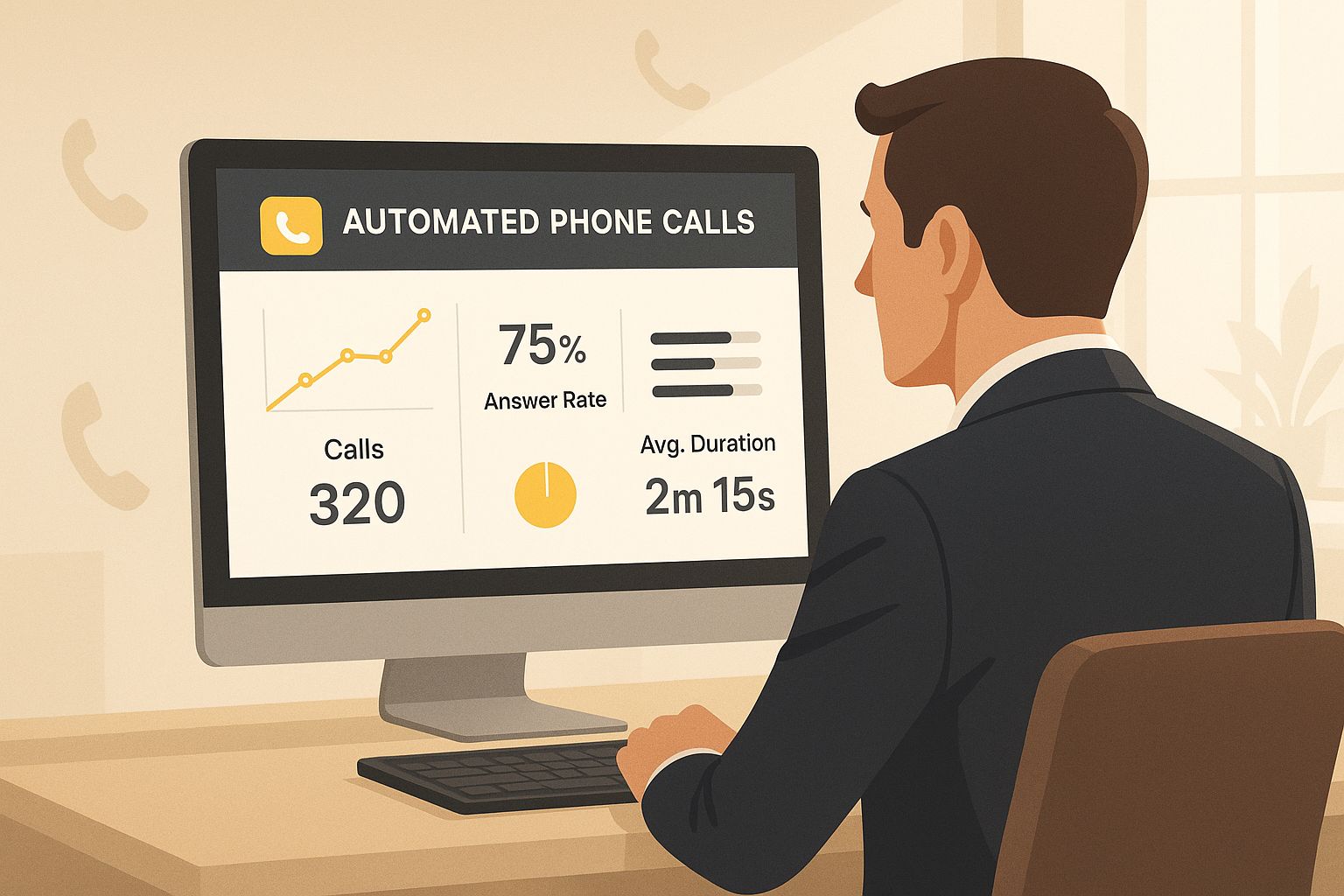Picture having a digital assistant who handles all your routine calls with flawless consistency, freeing up your team to tackle the more complex, high-value work. That's really what automated phone calls are all about. These systems use technology to dial numbers, play messages, and even collect information, shifting them from the annoying 'robocalls' we all dread into genuinely powerful communication tools for business.
So, How Do Automated Phone Calls Actually Work?
At its heart, an automated phone call system is like a super-efficient digital switchboard operator. Instead of a person manually punching in numbers from a list one by one, the software takes care of the whole show. It all starts with a list of phone numbers, which is often pulled straight from your CRM or another database.
From there, the system starts dialling these numbers at a speed and scale that would be impossible for a human team. Once someone answers, the tech kicks in to deliver a pre-planned message or start an interaction. This is where you see the different levels of technology come into play.
The Technology Behind the Call
Let's break down the different systems you might come across. To make it a bit clearer, here’s a quick snapshot of the most common types of automated calling technology and what they do best.
A Snapshot of Automated Calling Systems
| System Type | Primary Function | Common Use Case |
|---|---|---|
| Auto-Dialer | Dials numbers from a list and plays a pre-recorded message. | Mass announcements, appointment reminders, emergency alerts. |
| Interactive Voice Response (IVR) | Guides callers through a menu using keypad or voice prompts. | Routing calls to the right department, checking account balances. |
| Conversational AI | Engages in natural, human-like dialogue to understand and respond. | Lead qualification, scheduling appointments, customer surveys. |
As you can see, the technology ranges from simple one-way broadcasts to sophisticated two-way conversations.
The most basic form of automation uses a simple auto-dialer. This tech just calls a number and, once it connects, plays a pre-recorded audio file. It’s a one-way street, perfect for mass announcements or simple alerts where you don't need a reply.
Moving up a notch, we have Interactive Voice Response (IVR). You've definitely used this before. Think of the phone menu that says, “Press 1 for sales, Press 2 for support.” IVR systems are designed to get callers to the right place or give out basic info without tying up a live agent, helping to organise the flow of incoming calls.
The most advanced setups use conversational AI. This is where things get really clever. Instead of just following a simple menu, this technology can actually hold a natural, human-like conversation. It understands spoken questions, figures out what the caller wants, and gives relevant answers. It's brilliant for things like qualifying sales leads or booking appointments.
This image shows how all these different pieces can work together in a single, cohesive system.

It really highlights how a central dashboard can manage everything from a basic auto-dialer to complex AI chats, giving a business total control over its communications.
The Complete Process from Dial to Data
So, what does this look like in action, from start to finish?
- Initiation: The whole process kicks off with a trigger. This could be anything from a new lead popping into your CRM, an appointment time getting close, or someone on your team manually starting a campaign.
- Dialling and Connection: The platform automatically dials the right phone number. It’s also smart enough to tell if it's reached a real person, a voicemail, or a dead number.
- Interaction: Once connected, the system does its thing. This might be playing an automated voice message, guiding someone through an IVR menu, or having a full-blown AI conversation to gather information.
- Data Capture: As the interaction happens, the system is busy logging all the important details. This includes what happened on the call (answered, busy, failed), any buttons pressed in an IVR, or even a transcript of the conversation.
- Integration: Lastly, all this data gets pushed straight back into your other business systems, like your CRM. This closes the loop, automatically updating customer records and even setting off follow-up tasks for your team.
Right then, let's look at the real-world impact of call automation on your business.
The True Business Impact of Call Automation
Getting your head around the tech is one thing, but seeing how it can give your business a serious strategic edge is where things get interesting. For businesses here in Australia, bringing in automated phone calls isn't just a minor tweak; it's a massive shift in how you operate. The benefits go way beyond just making calls faster—they touch everything from your bottom line to how happy your team is at the end of the day.
At its heart, automation is all about efficiency. Picture a small team trying to call hundreds of clients to confirm appointments. Doing that manually is a slow, soul-crushing job that can chew up entire workdays. With an automated system, that same team can reach out to thousands of customers in the time it used to take to make just a few calls.
Boosting Productivity and Profitability
This new efficiency directly pumps up your profits and, more importantly, frees up your best people. Instead of being stuck on the phone doing repetitive dialling, your team can focus on the stuff that really matters: solving complex customer problems, building relationships, and closing those big deals. That's where the real growth happens.
By automating all those routine calls, both coming in and going out, you're letting your skilled staff focus purely on the interactions that need a human touch—the ones requiring clever thinking and real empathy. This doesn't just make them happier; it lets them add way more value to the business.
The numbers back this up, too. In Australia, a lot of businesses pair automated phone systems with call centre outsourcing. In fact, over 70% of Aussie businesses see this combo not just as a way to cut costs, but as a smart move to actually improve their service quality. They're reporting cost savings between 25-45% compared to keeping it all in-house, thanks to lower overheads and training costs. You can discover more about these Australian call centre trends and see the financial impact for yourself.
Achieving Scale and Consistency
Another huge win is making sure every single customer interaction is consistent. When people make calls, the message can change slightly from one person to the next, which can cause confusion or mix-ups. Automated systems, on the other hand, deliver the exact same message, every single time. This is perfect for critical info like:
- Appointment Reminders: Cutting down on no-shows and keeping your schedule running like clockwork.
- Payment Due Alerts: Improving your cash flow with polite, timely pings.
- Service Updates: Keeping your customers in the loop about important changes or outages.
This level of consistency builds trust and gives customers a reliable experience they can count on. Plus, automation lets you scale up or down without breaking a sweat. Whether you need to contact 50 customers or 50,000, the system just handles it. You don't have to scramble to hire and train a bunch of temps. This agility means your business can jump on opportunities or handle challenges on the fly, growing smoothly without the usual headaches. It’s all about working smarter, not harder.
Real-World Examples of Automated Calls in Action

Theory is all well and good, but seeing how automated phone calls actually work in the real world is where it all starts to click. Right now, across Australia, businesses big and small are using this tech to solve everyday headaches, level up their customer service, and give their bottom line a healthy boost.
These aren't some far-off, futuristic concepts; they're practical strategies being put to work today.
Take a busy healthcare clinic in Melbourne, for instance. Not long ago, the reception staff would spend hours every single day manually calling patients to confirm appointments. Now, an automated system gives each patient a friendly, pre-recorded reminder call two days before their booking. That one simple change has slashed the number of no-shows, kept the appointment book full, and freed up staff to focus on the patients right there in the clinic.
Applications Across Different Industries
The beauty of this technology is that it isn't a one-trick pony. It’s incredibly versatile, helping businesses tackle specific pain points across a whole range of fields.
- Real Estate Viewings: A Sydney-based agency uses automated calls to instantly confirm private viewing times with keen buyers. If a buyer pulls out, the system is smart enough to offer that slot to the next person on the waitlist. No more wasted time for agents.
- Retail Order Updates: An e-commerce store automatically calls customers to let them know their order is on its way. This simple, proactive heads-up cuts down on all those "Where's my order?" calls and keeps customers happy.
- Financial Services: Financial advisors are using clever AI callers to follow up on initial enquiries. The AI can ask a few qualifying questions and then book a detailed chat with a human advisor, making sure leads are properly warmed up before taking up an expert's valuable time.
The goal here isn't to get rid of human interaction altogether. It’s about automating the repetitive, high-volume stuff so your skilled team can pour their energy into the complex, high-value conversations that actually grow the business.
The Australian Consumer Perspective
Of course, none of this matters if customers hate the experience. Research into Aussie attitudes has found that while 62% of people are a bit wary of AI-driven calls at first, that feeling disappears when the call is genuinely helpful.
The trick in Australia isn't to perfectly mimic a human. It's about being upfront and offering a conversational experience that solves a problem quickly and efficiently. Early adopters in real estate, healthcare, and finance are finding real success by tailoring their automated calls to fit these local preferences. You can discover more about Australian AI call adoption and see how different sectors are making it work for them.
It's this tailored approach that's turning what was once seen as an impersonal technology into a seriously effective and trusted communication tool.
Choosing the Right Automated Calling Platform
Picking the right platform for your automated phone calls is a big deal – it can genuinely make or break your success. The market is flooded with options, from basic message blasters to incredibly smart conversational systems. The trick is to match the tech's capabilities to what you actually need to achieve in your business.
Think of it like choosing a vehicle for a job. A simple ute is spot-on for a quick tip run, but you wouldn't use it to haul goods across the country; you’d need a proper prime mover for that. It’s the same with calling platforms. A basic auto-dialler that just plays a recording is great for mass appointment reminders, but it’s completely out of its depth if you’re trying to qualify leads or sort out complex customer problems.
Define Your Interaction Needs
First things first, you need to be crystal clear about the level of interaction your calls require. Are you just broadcasting information one-way, or do you need a system that can actually listen and respond to what a customer is saying? Answering this question will slash your list of options in half.
The core decision really boils down to one-way versus two-way communication. If your goal is simply to get a message out there without needing a reply, a basic system will do the trick. But if you’re looking to gather info, book appointments, or solve problems, you need a platform with interactive smarts.
For businesses that are all about qualifying leads or handling customer service, a platform with conversational AI is a must-have. These systems can hold a surprisingly natural chat, figure out what the caller wants, and make decisions on the fly. It's no surprise that one study found 73% of customers would rather solve issues themselves, and a smart interactive system is the perfect tool to help them do just that.
Integration and Scalability
Your new platform can't be an island. It absolutely has to integrate seamlessly with your existing Customer Relationship Management (CRM) software. This is non-negotiable. Proper integration means all your call data—like who you called and what was said—gets logged straight into the right customer record. This gives you a complete, up-to-date picture of every interaction.
You also need to think about the future. A platform might tick all the boxes today, but can it grow with you? Look for solutions that can handle more calls as your business expands, without falling over or hitting you with a massive price hike. This kind of forward-thinking saves you the major headache of having to switch systems right when things are getting busy. A solid system often becomes the backbone of a wider call management software strategy, setting you up for future growth.
At the end of the day, the best platform isn't just about the price tag. It's the one that fits snugly into your daily workflow and supports your long-term goals.
Using Automated Calls Ethically and Effectively

Let’s be honest, the secret to getting automated phone calls right comes down to one simple thing: building trust, not torching it. While the tech offers incredible efficiency, a clumsy or irresponsible approach is the fastest way to alienate customers and give your brand a bad name.
This is where putting the customer experience front and centre makes all the difference. Every automated call should feel helpful, not pushy. The real goal is to provide genuine value, whether it’s a handy appointment reminder or a quick update on an order.
Adhering to Australian Regulations
Here in Australia, the rules around automated calling are strict for a good reason. The Australian Communications and Media Authority (ACMA) has clear guidelines to protect people from being hassled. Ignoring them isn't just bad form—it can land you in some serious hot water.
Your number one priority has to be the Do Not Call Register. Before you even think about launching a campaign, you absolutely must scrub your contact list against this register. You’ve got to remove anyone who has said "no thanks" to telemarketing calls.
Keep in mind, the responsibility for staying compliant is all on you. Claiming you didn't know the rules won't fly, and the penalties for getting it wrong can be pretty hefty. It really drives home why a careful, ethical strategy is non-negotiable.
On top of that, there are strict rules about when you can call. As a general guide, telemarketing calls are a no-go on national public holidays. They’re also banned before 9 am or after 8 pm on weekdays, and before 9 am or after 5 pm on Saturdays. It always pays to check the latest ACMA guidelines to make sure you're completely up to scratch.
Best Practices for Building Trust
But staying on the right side of the law is just the starting point. To create a genuinely positive experience, you need to be a bit more thoughtful.
Here are a few essential practices to keep in mind:
- Get Proper Consent: Only call people who have clearly given you the green light. This needs to be explicit permission, not something sneakily buried in the fine print.
- Identify Yourself Clearly: Every call should kick off by stating who you are and what your business is. Any vagueness right at the start just makes people suspicious.
- Provide Real Value: Make sure every single call has a clear, helpful purpose for the person on the other end. A call that saves them time or gives them crucial info will always be welcomed.
- Offer a Simple Way Out: It should be incredibly easy for someone to opt-out of future calls. A simple "press 9 to unsubscribe" option is an absolute must.
- Monitor and Improve: Always keep an eye on how your calls are performing and listen to feedback. Use that data to tweak your scripts and timing so the experience gets better over time, helping you avoid the classic mistakes that give automation a bad rap.
Navigating Australian Regulations and Scams
Using automated phone calls in Australia is a bit of a balancing act. On one hand, the tech is incredibly handy. On the other, you've got to deal with the dual risks of scams and some pretty strict regulations. Criminals have misused this technology so much that the public is, quite rightly, a bit suspicious of any automated call. For any legitimate business, that means you have to operate with absolute integrity to protect both your customers and your good name.
The scam threat is no joke. In a recent year, Aussies lost over $2 billion to all sorts of scams, and dodgy automated calls were a big part of that problem. These scammers are getting slick, using tactics like spoofing numbers to look like they're from a local area or even using AI deepfakes to impersonate banks or government agencies. It's becoming harder for people to know who to trust. As you can learn more about the top scam threats facing Australians, this mess has put legitimate businesses under the microscope, too.
Staying on the Right Side of ACMA Rules
The Australian Communications and Media Authority (ACMA) has laid down some clear rules for anyone making telemarketing or research calls. Let's be clear: automated calling technology itself is perfectly legal. But if you misuse it, you're in for some serious penalties. Staying compliant isn't just a box-ticking exercise; it's fundamental to running a responsible business.
Here are the absolute must-dos to stay compliant:
- The Do Not Call Register: Before you call anyone, you have to check your list against this register. If someone's on it, you can't call them for marketing. Simple as that.
- Restricted Calling Hours: No unsolicited calls on national public holidays. On weekdays, you can only call between 9 am and 8 pm. On Saturdays, the window is even smaller: 9 am to 5 pm.
- Clear Identification: Right at the start of every call, you must clearly state who you are and which business you represent.
It's worth remembering that ignoring these rules doesn't just put you at risk of hefty fines. It can completely destroy the trust you've worked so hard to build with your customers. The buck stops with your business to make sure every automated call is compliant, transparent, and genuinely useful.
Protecting your customers—and your business—from this risky environment is non-negotiable. A great move is to actively teach your clients how to stop unwanted phone calls and spot the red flags of a scam. When you operate ethically and help your audience stay safe, you’re not just following the rules; you’re building a reputation as a brand people can truly trust.
Got a few questions swirling around about how automated phone calls work in the real world? It's completely normal. Let's tackle some of the most common queries we hear from Aussie businesses ready to make the switch.
Can I Customise the Voice and Message?
You sure can. These days, the level of customisation is fantastic.
If you want to keep that personal touch, you can simply record messages in your own voice or get a team member to do it. But if you're short on time, modern text-to-speech (TTS) tech is a lifesaver. Just type out what you want to say, and a surprisingly natural-sounding AI voice will take care of the rest. You can even pick different accents and tones to get it just right.
How Do I Handle Voicemails?
Good question. Modern systems are smart enough to know when they've hit an answering machine, giving you a couple of clear choices.
- Leave a Message: You can set it up to drop a pre-recorded message automatically.
- Hang Up and Retry: Or, you can tell the system to just hang up without saying a word and maybe circle back later.
It’s a good idea to sort out your voicemail strategy before you kick things off. Dropping a quick, helpful message works great for reminders. But for calls that need a back-and-forth, it's often better to hang up and log it for a proper follow-up.
Are Automated Phone Calls Expensive?
The price can vary a bit, but it’s often a lot more affordable than people assume. Basic systems that just play a recorded message are very light on the wallet, usually charging per call or per minute. The more advanced conversational AI platforms will have higher setup and running costs, as you'd expect.
But the real story is in the return on your investment. When you add up all the staff hours you get back and how much smoother everything runs, most businesses find that automated calling pays for itself in no time.
Ready to reclaim your time and never miss an important message again? OnSilent transforms your call management with smart voicemail, spam filtering, and intuitive controls. Find out how you can save hours each week by visiting our website.

